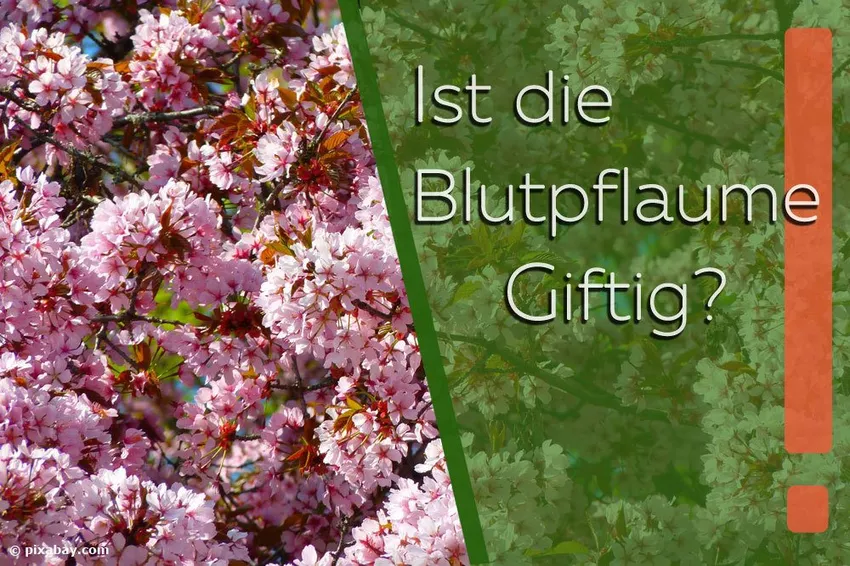
With its more or less red colored foliage, the blood plum (bot. Prunus cerasifera) is an eye-catcher in the garden and a pleasant change in the orchard. Older breeds lose their red color over the course of the year, while younger ones do not. However, there is often uncertainty about the edibility or toxicity of the fruit, especially since blood plums are often sold as ornamental trees.
toxicity
Which parts of the blood plum are really poisonous?
The blood plum is basically not toxic. The pulp of some species of blood plum is not only edible but very tasty and sweet, something like a mixture of custard and mirabelle plum. However, the taste varies from variety to variety, some species even taste quite bland and mealy. They are practically only suitable as ornamental trees. However, the fruits should not be eaten when they are unripe, as they easily cause diarrhea and nausea. However, only those contained in the seeds are really poisonous seed.
ingredients
What toxins does blood plum contain?
Blood plum seeds contain amygdalin, also called vitamin B17 in alternative medicine. This is a relatively stable cyanide compound, a precursor to the well-known ones hydrogen cyanide. It can be found in all rose plants, including Prunus cerasifera. When combined with water and certain enzymes, amygdalin breaks down into hydrocyanic acid.
It is less well known that many foods contain hydrocyanic acid, sometimes in very small amounts (peas, bamboo shoots, strawberries, haricot beans), but often also in somewhat higher concentrations. These include lima beans, apricot kernels, bitter almonds, yams, and tapioca. However, through various preparation methods, such as cooking, the hydrocyanic acid is reduced to a harmless level.
edibility
pulp
What should I consider when preparing blood plums?
Blood plums can be used in a variety of ways in the kitchen, but they are also a real treat raw. However, you should check the taste of your fruit before processing, as some varieties are actually more suitable as ornamental shrubs due to their bland taste. In appearance, blood plums are similar to other plums, they are only usually smaller and the flesh is more or less intensely red in colour.
If you have a tasty variety of Prunus cerasifera in your garden, you can use it to cook jam or plum jam in the usual way, or to bake a delicious plum cake with it. Refine your muesli for breakfast or your fruit salad for dessert with the raw plums. But make sure that the fruits are really ripe, so that nobody gets a stomach ache afterwards. You should also not damage the seeds when removing the pulp.
Valuable components of blood plums
- vitamins
- minerals
- trace elements
- fruit acids
- pectins
- plant dyes
cores
Can I also use the cores somehow?
In alternative medicine, the raw consumption of one or two seeds a day is often recommended for cancer prevention or treatment. The vitamin B17 contained in it should behave neutrally in living organisms and therefore only affect the cancer cells. However, this is not advisable, because it is still a toxic substance whose healing properties have not been proven in studies. In addition, people with a nut allergy extra caution, as you could also be allergic to the blood plum seeds.
But you can make a wonderful one from the seeds of your blood plums Plum Kernel Liqueur produce. Its taste is similar to the well-known Amaretto. However, if you only use intact, undamaged seeds in your liqueur kitchen, then no unwanted substances can migrate into the finished liqueur.
Plum seed liqueur recipe
ingredients
- about 500 grams of clean, dry plum stones
- 750 ml high-proof clear schnapps
- 100 to 200 grams of sugar or rock candy and
- much patience
Put all the ingredients in a screw-top jar and put the closed jar in a dark place for at least four to five weeks. From time to time you should shake it slightly. Then strain the liqueur through cheesecloth and pour it into a pretty glass bottle. If you want a Christmassy flavor, add a small cinnamon stick, some vanilla and cloves to the screw-top jar. Use brown cane sugar instead of white sugar.

